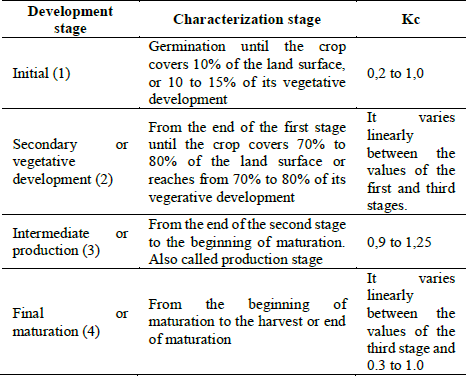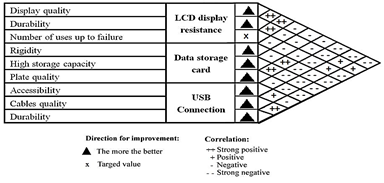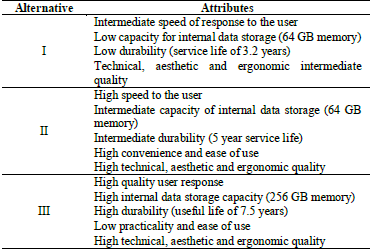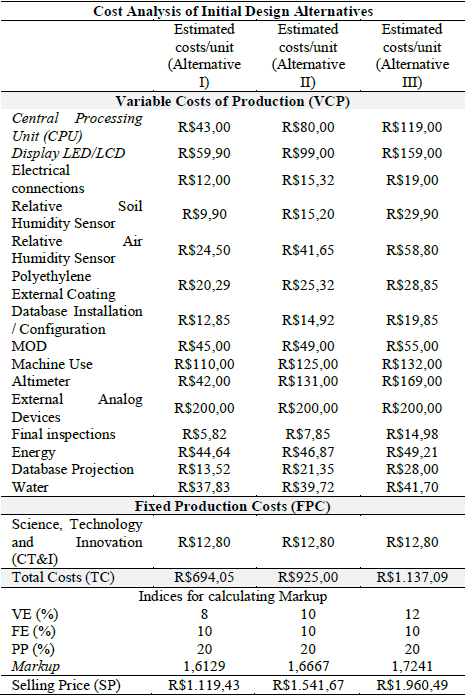1. Introduction
The irrigation process, worldwide, has been widely used as an alternative to develop different crops [1,42]. Thus, this process is directly associated to the food production sector, making feasible to perform a larger number of harvests in a given period of time [2]. However, it is worth mentioning the amount of water used in irrigated agriculture, which represents 69% of all drinking water in the world [3]. However, the use of this process has become more of a concern, for requiring a high amount of water resources, and currently there are regions with restricted water availability [4,5,44].
In Brazil, crop irrigation also stands out in relation to water consumption [6]. In the case of sprinkler irrigation, Brazil has approximately twenty thousand central pivots that irrigate about one million hectares [7]. Thus, Brazil has a position among the ten countries with the largest irrigated area in the world, in addition to presenting a high resource availability corresponding to 8% of world reserves [4,46]. However, considering the present inequality in the distribution of the resource in the Brazilian territory is necessary, so that the northeastern region, for example, is a region desolated by water scarcity and precariousness of soils [8,47,48].
In this context, the development of new measures that allow the conscious resource consumption is of fundamental importance, and support in new technologies becomes viable. Moreover, product innovation and the implementation of incremental improvements in agriculture is also important to reduce water consumption and make water use more efficient [9-11]. Thus, innovation must be considered as an integrated process and not only as an isolated event [12,13]. The innovative process can be expressed in the stages of prospection, ideation, strategy construction, resource mobilization, implementation and evaluation [9,14]. In addition, the act of innovating requires generating new ideas, the breaking of paradigms and the promotion of new perspectives on the analyzed reality [15].
When it comes to innovation processes, it is worth emphasizing product innovation as an alternative to problem solving. The Product Development Process (PDP) guarantees companies a knowledge structure, so that it has a direct relationship with the level of customer acceptance [16]. This fact promotes greater market competitiveness, besides leveraging the development of new products with higher quality levels [17]. PDP evolution influences the reduction of the product life cycle, which increases the innovation challenges [16,18,19].
At the confluence between the development of new products and the sprinkling irrigation process, the digital irrigation system is a successful alternative to control the water to be sprinkled. The irrigation system corresponds to a versatile and adjustable device that estimates the amount of water lost in the evapotranspiration process of the plant [20]. Thus, by means of simple methods of controlling the existing valves, the proper management of the amount of water in the irrigation processes occurs [21]. In addition, the apparatus allows the knowledge of amount of water to be irrigated by type of crop, the appropriate time to be irrigated, as well as the duration of the process [20,21]. So, this paper aimed to propose the development of an innovative product aimed at the correct dimensioning of the amount of water to be used in crop irrigation.
2. Product Development Process (PDP) and innovation management in the agricultural sector
Product Development Process (PDP), in a recent context, addresses the manipulation and allocation of resources that are necessary to obtain the product or service [22]. Moreover, the relationship between several variables involved in a project is a factor to be considered, since these can undergo constant changes and cause disequilibrium in the project [23,24]. A relevant aspect in the development of products bases on the market needs, it means, PDP seeks to meet and satisfy an identified market gap [25]. In this context, the high level of uncertainty should be considered, especially in the initial project phases, which contemplate the concept of product or service [26].
Innovation in the product development process considers the implementation of new ideas, be they administrative, technological or procedural [27]. In addition, these can be of incremental character when it comes to the improvement of existing products, or of a radical nature, when creating new products or services [28]. The innovative process does not correspond to a deterministic practice, so that to reach its effectiveness it is necessary to develop integration activities that promote greater interaction among the participants of a project [12,13].
Currently, the use of innovation processes to solve daily problems has become recurrent [28]. As a result, one of the problems experienced by the population corresponds to the lack of water, mainly in regions with a dry climate [27,29]. As for the consumption of this resource, there are several possibilities for its optimization that use innovative practices [30]. In addition to these practices, some changes related to the management, allocation and preservation of the resource have been made. However, the modification of consumption patterns is also important [31].
When dealing specifically with the Brazilian territory, this presents an inequality picture in water resource distribution. Although the country has a considerable abundance of resources, the issues of scarcity and quality of resource are already a reality. In addition, in many cases there is a lack of knowledge, skill and experience on the part of users for proper exploitation and use of water. As a result, about 40% of the resource is wasted with irrational practices in the Brazilian territory [32,33].
In the last years, the agricultural sector has conceived a production growth worldwide [32]. However, it did not surpass population growth, a fact that tests food supply conditions [34]. In addition to this, there are also issues such as soil degradation, water scarcity and lack of effectiveness in the use of pesticides, which together converge to inefficiency in increasing agricultural production [4]. This sector corresponds to one of the largest consumers of water. Thus, it is necessary to carry out incentive policies for a sustainable management and handling of this resource [35]. One of the alternatives is the use of irrigation systems, which allow both consumption reduction and the achievement of multiple harvests [4].
3. Methodology
Once the Hargreaves-Samani Method calculated the potential evapotranspiration rate of reference, it could estimate the actual evapotranspiration rate of each crop. Therefore, in order to estimate the optimal amount of water precipitation per square meter, the product used local data collected by the operating equipment system, such as barometric pressure, maximum and minimum temperature, altitude and local latitude together with data provided by the user such as, the type of local soil, crop and their stage of life. The Hargreaves-Samani method was used to calculate the actual evapotranspiration rate of the crop (ET c ) according to the local climatic conditions in relation to the potential evapotranspiration rate of reference (ET 0 ) and the evapotranspiration rate of a given crop (ET pc ).
By definition, (ET pc ).is the evapotranspiration of a given crop when it has excellent conditions of field humidity [4]. According to authors [4], under normal crop conditions of plants of short cycle, ET pc is much smaller than the reference evapotranspiration (ET 0 ).Thus, this difference decreases as the crop develops, that is, due to its leaf increase, tending towards a minimum difference, in many cases reaching a value of (ET 0 ).when the culture reaches ±80% of its vegetative development or the beginning of the formation of the floral primordia, remaining in this condition until the end of the filling phase of the grains, after which the difference returns again [4]. Fig. 1 shows the relationship between the potential evapotranspiration of a crop (ET pc ).and potential reference evapotranspiration (ET 0 ).
The relation between (ET pc ).and (ET 0 ).is expressed by eq. (1):
in which (K c ) is the crop coefficient. The values of (K c ) vary with crop type and local climatic conditions. Also according to Fig. 1, the irrigation frequency of a given crop depends on both the type of climate and the phase of the crop cycle. In order to simplify the calculations to be performed by the Operating System of the device, the values of (K c ) for each type of culture will be calculated based on four different stages of crop development [4]. Table 1 shows a description of each of the development stages as well as the corresponding value of (K c ) for each of these stages.
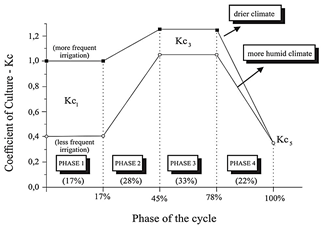
Source: Adapted from [4].
Figure 1 Relationship between the potential evapotranspiration of a crop (ET pc ).and potential reference evapotranspiration (ET 0 ).
Table 1 shows that among the stages of crop development, the initial stage requires more attention, requiring a more intensive irrigation in this period. The higher the local evapotranspirometric demand or the more sensitive the plant is to the water deficit in the soil, the higher the value of K c the value of K c in the initial stage is mainly related to the evaporation of the soil. Thus, it depends on evapotranspirometric demand and local soil humidity, that is, on the frequency of irrigation or rainfall [4]. Fig. 2 shows the relationship between K c , ET 0 and the frequency of irrigation or rainfall.
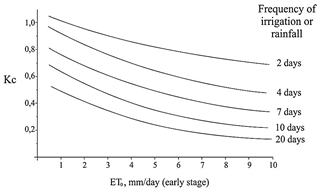
Source: Adapted from [4].
Figure 2 Values of K c in the initial stage due to ET 0 and the frequency of irrigation or rainfall.
Also according to Fig. 2, there is an indirect relationship between the value of the crop coefficient (K c , ) and the potential evapotranspiration reference value (ET 0 ) which means the need for varying amounts of water over the days to culture maintenance. The determination of ET pc is of paramount importance in order to calculate the amount of irrigation required (ITN) in the period of maximum irrigation demand, which is fundamental for the design of any irrigation system. The ET pc is also required to calculate actual crop evapotranspiration (ET c ) [4]. Still according to authors [4], when the value of K c is unknown for a given crop in a region, one can assume the value Kc=1,00 Kc=1,00, that is, to estimate it based on potential evapotranspiration of reference (ET 0 ), calculated by the Hargreaves-Samani Method.
By definition,ET c is the evapotranspiration of a given crop, under normal growing conditions, that is, without the moisture content always remaining close to the field capacity. Thus, ET c will be smaller or at most equal to ETpc According to this proposition, the relation between ET c and ETpc is expressed by the equation: ET c =K s .ET pc ET c =K s .ET pc , in which K s is the coefficient that depends on soil humidity. Thus, the optimal amount of water to be used in irrigation, in mm/dia, is equivalent to ET c [4].
According to authors [4], the coefficient for soil humidity (K s ), for conversion of ET pc into ETc, due to soil water availability is given by equation (2):
in which K s is the coefficient of soil humidity (dimensionless), CTA the total of soil water capacity, in mm, and LAA the current slide of water in the soil, in mm.
4. Results and discussion
4.1 Hargreaves-Samani methodology application
The present study is about the development of a product that estimates the amount of water to be used in irrigation, based on the calculated value for evapotranspiration of a particular culture. Therefore, its operation is based on the insertion of primary data, as minimum and maximum environment temperature, the crop coefficient (K c , ), the current ground water blade (LAA) and the total ground water capacity (CTA). Thus, some estimates were calculated through mathematical programming, supported by Microsoft ® Excel ® 2016 MSO (16.0.4266.1001) 64 bits.
Thereby, some tests were performed considering a particular type of culture and the minimum and maximum environment temperature of the region addressed. Initially, with the insertion of the initial input data, in this case, minimum and maximum temperature, the potential evapotranspiration rate of reference (ET 0 ) was calculated, according to the eq. (3) obtained by the Hargreaves-Samani Method [36], using regression analysis on daily data of Davis-California reference potential evapotranspiration:
in which ET 0 = transpiration rate of reference potential, in mm/dia, T med = daily mean temperature, in °C, T max = daily maximum temperature, in °C, T min =daily minimum temperature, in °C and R a = radiation at the top of the atmosphere, MJ .m -2 .day -1 .The value corresponding to the radiation at the top of the atmosphere (R a )is tabulated according to local latitude. Thus, the optimal amount of water to be used in irrigation is equivalent to the actual transpiration rate of a given crop [37].
Then, the crop coefficient (K c ) value considered was requested, thus making it possible to calculate the evapotranspiration rate of the specific crop (ET pc ), obtained by multiplying (ET 0 ) by (K c , ) (2). The last step of the calculations occurs in two phases, firstly, with the insertion, by the operator, of the data concerning of current ground water blade (LAA) and total ground water capacity (CTA) to obtain the coefficient for soil humidity (K s ), according to equation (1). Lastly, the estimated value for the coefficient for soil humidity (K s ) was multiplied by the value of evapotranspiration rate (ET pc ),obtaining the water evapotranspiration of this crop (ET c ), which is equivalent to the optimal amount of water to be used in irrigation.
It is important to remember that the region considered for the calculations is the mesoregion of Alto Paranaíba, located in the state of Minas Gerais, Brazil. This region is located at latitude of 19 degrees. Regarding the type of crop considered, the calculations were made based on carrot cultivation, because it is a typical crop of the region, besides being well adapted to the climate, and can be grown in different seasons of the year. According to [41], the Alto Paranaíba region is responsible for more than 70% of the harvested area of the country, about 5147 ha. In this way, its cultivation contemplates four stages: stage I - sowing until emergence (30 days), stage II - emergence until the maximum of vegetative potencial (14 days), stage III - root development (40 days), e o stage IV - maturation (10 days) [38]. Table 2 comprises a period of one year, in which four plantations were simulated, each referring to a season of the year.
Table 2 Calculations of the optimum amount of water required for the carrot crop
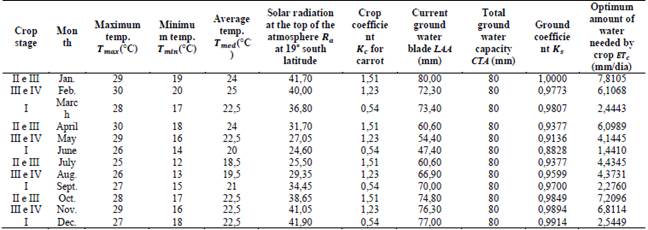
Source: The authors.
According to Table 2, high values for the carrot coefficient K c can be observed, due to the variations in precipitation and soil evaporation rate in the region during the analysis period [38]. It is important to note that this period corresponded to the year 2017, in which data were collected referring to the historical series of maximum and minimum temperatures [39]. According to data presented by authors [4], solar radiation at the top of the atmosphere (R a ) was obtained based on the mean values presented for latitudes of 18 and 20 degrees. As the values of current water blade (LAA) and total ground water capacity (CTA) for the region, it was possible to measure carrot evapotranspiration (ET c ) for each of its stages, meaning the amount of water required for irrigation in millimeters per day.
In order to complement this study, a comparative analysis between the data provided in the literature and the estimated values was performed. However, this study focused on only one product proposal, and was not designed in practice from a materialized product. According to authors [40] the values of carrot crop coefficient (K c ) for the four stages in the mesoregion of Rio Paranaíba, are respectively 1,15, 1,12, 1,12 e 1,10. Thereby, the values for the evapotranspiration of the crop were calculated according to these data, and then compared with the previously obtained values, as shown in Table 3.
Table 3 Comparison of values of (ET c ) estimated on the basis of literature and verified data
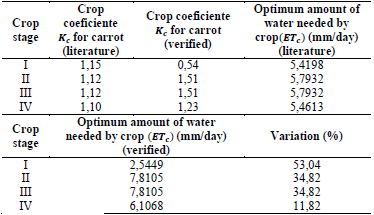
Source: The authors.
The analysis described in Table 3, comprises a crop beginning in the month of December and ending in February. The percentage variations obtained between evapotranspiration values reinforce the impact of climate parameter changes at each stage of crop development. In this way, the simulation of these data represented a great contribution to the study, allowing the alignment of theoretical and practical knowledge.
4.2 Product development
Due to the initial alternatives of product design, using the innovation funnel principle, it was possible to "filter" all the information and requirements of the initial design alternatives, generating the final alternative adopted in this study. The innovation funnel is composed of three phases, they are the generation of ideas, detailing the project proposal and, finally, the project development. The generation of ideas contemplates the development of the product concept, where from the brainstorming sections there will be the identification and revision of the initial project proposal. Then, after the maturity of the initial proposal, in the detailing phase there will be recognition of the limitations of the project. Finally, in the final phase of development, final project adjustments will be made.
The idea of the innovation funnel is to show that options are discarded to the extent that ideas converge to a continuous reduction of uncertainties of a project or a set of projects [10]. According to innovation funnel principles, the filtering process contributes to the agile and efficient development of projects. Thus, the first stage of this study contemplated brainstorming among team members to define an initial concept of the product. Therefore, some tools were used to help the final conceptualization of the product, among them, Market Research, Failure Mode and Effect Analysis (FMEA), Quality Function Deployment (QFD) and SWOT Analysis (Strengths, Weaknesses, Opportunities and Threats).
Market Research was conducted in order to obtain insight into customers' expectations regarding the proposed innovative product as well as the key product requirements. The study was developed using online and printed questionnaires directed to individuals who are active in the sector such as agricultural technicians, farmers, engineers and academics. In addition, it was verified the existence of a market gap represented by individuals who perform the sizing of water sprinkled in the crops, however, it present problems related to the accuracy of the estimated value of water. Thus, most of the interviewees showed an interest in acquiring the innovative product. According to them, the most relevant criteria were flexibility, that is, the possibility of replication for different cultures, and the response speed corresponding to a high capacity processing.
The FMEA method allowed the identification of possible failures inherent to the product, as well as the hierarchization of these by calculating the risk value associated with each failure, in addition to proposing solution strategies for each type of identified fault. In this context, there were failures related to the product components, such as data display, data loss, USB connection, altitude check, air humidity check, soil humidity check and failure of the polymer used in carcass preparation. The effects of such failures relate to the infeasibility of water design and product use, generation of damages to the internal components and the infeasibility of subsequent estimates. Thus, the failures related to the LCD display, storage card and USB connection had the highest risk levels. Finally, the proposed corrective actions corresponded to the inspection and exchange of the components of the product.
In this study, both the brainstorming and the market research sections helped to define the product requirements, which were later translated into technical characteristics of the product, according to Table 4.
As shown in Fig. 3, the characteristics of the product were the LCD display resistance, the quality of the data storage card and USB connection. Then, through the generation of a correlation matrix, it was observed the interaction between the previously defined product requirements and the technical characteristics, as shown in Fig. 3.
In relation to the existing relationships between the requirements and the technical characteristics, by analyzing Fig. 3, it was observed the existence of few positive relations, that is, when one characteristic influences the other. In addition, there were strong positive correlations, in which one characteristic strongly influences the other, for example, the quality of the screen and durability of the product. Finally, absolute and relative weights were generated for each requirement, so that the main characteristics listed, that is, that presented higher values for the respective weights, were screen quality, high storage capacity of the plate, quality of the cables and storage card quality.
SWOT Analysis corresponds to a verification that assists in proving the viability of the product to be developed. In addition, in the external scope are the opportunities and threats of the product, and in the internal scope are its strengths and weaknesses. As a result, convenience, flexibility, speed of response, product strength and accuracy were positive aspects of the product. This is a new product on the market and consumers are dissatisfied with existing products. Other positive aspects are the climate, conscious use of water and the approval of special financing. However, as weaknesses there are the price and the need for a team capable of assembling the product. Finally, the threats relate to the market's resistance to adhere to the new product, economic crisis and to indirect competitors.
The analysis of competitors was based on surveys conducted on the website of the National Institute of Industrial Property (Instituto Nacional de Propriedade Intelectual - INPI), there were no direct competitors for the proposed innovative product. However, as indirect competitors, it was identified manual irrigation system, which presents a level of precision well below the proposed innovative product. This fact enhances the likelihood of the new product gaining market success.
For the product specifications, it has the following components: Central Processing Unit (CPU), LED/LCD display, electrical connections, relative air humidity sensor, relative soil humidity sensor, external coating in polyethylene, altimeter and external analog device. Based on this knowledge on the specifications, it became possible to form different alternatives for the final product. Table 5 shows the intrinsic attributes of the initial design alternatives.
The initial design alternatives, according to Table 4, contemplate three levels of development, that is, alternative I shows low and intermediate performance characteristics compared to the characteristics of alternative III. In addition, the cost analysis included the bill of materials (BOM), and the average price of each component used for final assembly of the product. Table 5 describes the analysis.
Subsequently, from the markup indicator, it was estimated the selling price of the final product, in the order of R$ 1,541.67, which may be adjusted over time in the light of the scope of the economy of scale and the IPI rate, inflation, among others.
The markup indicator calculation was based on equation (3):
in which 100 represents the total unit selling price as a percentage, DF for fixed expenses, and PP for the desired profit margin. For the markup calculations the following potentials were defined by brainstorming sections among members of the project: VE = 10.00%, FE = 10.00% and PP = 20.00%.
Finally, through a careful analysis of the proposed alternatives in relation to the needs of clients proven in the market research and systematic application of tools for innovation, quality, cost analysis and projects, the adopted alternative was Alternative II. This choice was based on the trade-off between the main requirements - flexibility and speed of response - and the final cost of the adopted alternative.
As a result, it was established the development of an innovative product that corresponded to the customers' expectations and that was accessible to all classes of verified clients. In addition, the alternative adopted in terms of technical components faithfully represents the initial proposal of the product design, since it has a high speed of response among its characteristics. It is worth emphasizing the practicality associated to the use of the product, fact that confers greater accessibility and understanding of all the users.
5. Conclusions
This study contemplated the development of an innovative product of high precision for the dimensioning of the optimum amount of water to be used in the irrigation of different crops. In addition, it was tried to provide advanced technological bases for the conscious and optimized use of the amount of water to be used in irrigation practices, since the inappropriate use of this resource in agricultural practices leads to a waste of fresh water of around 40%. Another relevant aspect corresponded to the speed level of response, flexibility and convenience associated with the product, which makes it an accessible and user-friendly product. With regard to the marketing plan of the product design, this corresponds to an aspect to be worked, since this study did not extend the commercialization.
It is important to clarify that the Digital Irrigameter proposed in this study is not a whole innovative product, and it cannot be considered a disruptive innovation. What is proposed is an incremental innovation, a digital system that can improve traditional central pivot/towable pivot systems. It is a solution less expensive and can be used in an easier way by ordinary farmers and producers.
Finally, through brainstorming allied to the innovation funnel, it was generated the formal alternative of the product through the initial alternatives of the project. Thus, the formal adopted alternative based on the trade-off between the main requirements - flexibility and speed of response - and the final cost of the adopted alternative.















